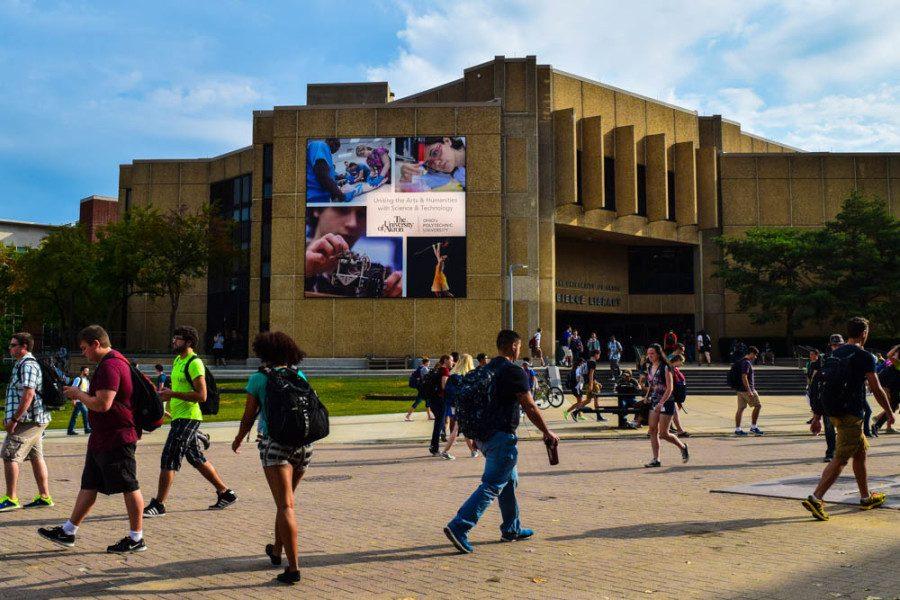Diversity: A Commitment or a Buzzword?
A look at diversity in academia and the concerns of those who value it.
Buchtelite file photo.
March 2, 2018
Is diversity just a buzzword for universities or is it a true mission? Throughout the 2000s, diversity on college campuses has received extra emphasis throughout university administrations across the United States.
Universities have made strides to show that their campuses are diverse places of learning. Once, whitewashed pamphlets, mailers and posters showed mainly only white males at a university. But according to a Washington Post report, this trend is changing as colleges have shown a more diverse group of students in official university publications. In addition to this, more than 100 major colleges across the U.S. have recently hired a “chief diversity officer” to oversee diversity initiatives at the university. However, university publications often over-represent certain populations in an effort to attract others. A study by Jennifer Spoor at La Trobe University in Australia conducted several experiments that changed the number of white and Asian students in a university flyer and charted students’ reactions of different representations of populations.
Diversity does not only apply to the color of one’s skin. The importance of diversity has also expanded to areas such as ethnicity, religion, gender, sexual orientation, socioeconomic status and a combination of the above including areas similar to first-generation college students, place of origin and immigration status. These are all areas universities must consider if they are striving to be truly diverse.
On the flip side of this coin, it would not be beneficial for students to be treated as tokens. This debate has mainly played itself out through discussions about Affirmative Action programs. The most beneficial way to work this issue out is through diversifying the applicant pool rather than looking at the pool of students being accepted into a particular university. If the pool of applicants to a university becomes more diverse, a natural outcome would be for those admitted to the university to be more collectively diverse.
A June 2004 article in the New York Time’s titled “Top Colleges Take More Blacks, but Which Ones?” looked at concerns of ethnic leaders regarding diversity on campuses. Henry Louis Gates, Jr. said many of the black students at Harvard are not of U.S. origin but rather from the Caribbean or Africa. Linda Martín Alcoff, a professor at the City University of New York, highlights an important point when it comes to the importance of diversity. Alcoff said, “if it’s about getting black faces in Harvard, then you’re doing fine. If it’s about making up for 200 to 500 years of slavery and its aftermath, then you’re not doing well.” This quote embodies many of the concerns about the authenticity of diversity.
The value of diversity also personifies itself in other ways such as programs and classes offered. The University of Akron just hosted their 11th annual series on race, “Rethinking Race” and this year the Women’s Studies Department is hosting “Rethinking Gender.” UA also offers several classes that focus on teaching diversity or are somehow related to the topic such as The Black Experience, Philosophy of Race, Intercultural Communication, Introduction to Pan African Studies, Human Diversity, U.S. Dialects: Black and White and many others.
Two instructors at UA had different outlooks on the topic of diversity at the University. Dr. Jess Otto, assistant professor of philosophy at UA, said it is important to have a mixture of people across those axes; the true value of diversity stems from the different experiences and perspectives that individuals bring to our in-class discussions and out-of-class interactions.”
Dr. Otto teaches “Philosophy of Race” at UA among other classes and hopes the class is added to the regular rotation of classes in the Philosophy Department. “However, on the other hand,” said Otto, “I think that like most universities, UA is suffering from economic woes. Historically, the Arts and Humanities have suffered the most during financial belt-tightening because we don’t produce anything, and tend not to attract the greatest numbers of majors.”
Dr. Otto continued and said, “If the University, or any university for that matter, truly valued diversity as a goal in and of itself, then the university in question would fight to keep these initiatives during hard times and would defend them against those who demand that they produce something. There are studies which indicate that diversity initiatives at law firms are often the first programs cut during economic downturns.”
“Sure, students may be from different races, economic backgrounds, or religions and for eight hours a day they are in the same classrooms, but do they truly interact with each other? Do individuals who work in a ‘diverse’ workplace interact with each other during lunch or on the weekends?” Dr. Otto raised these questions and others when asked about issues regarding diversity.
When asked if the University does a good job promoting diversity, another anonymous professor said, “yes, but it needs to be more than just promoting, it needs to be doing.” The professor went on and said there are currently good initiatives in place, but there are other areas the professor would like to see grow. This professor wanted to see more funding and support for growing Pan African Studies as well as agreeing with Dr.Otto in wanting classes that focused on diversity in areas outside of race and ethnicity.
Diversity initiatives will continue to grow on college campuses in the future. It is important to be conscious of some the questions raised here in order to ensure that these efforts to diversify universities are genuine and not misguided.












